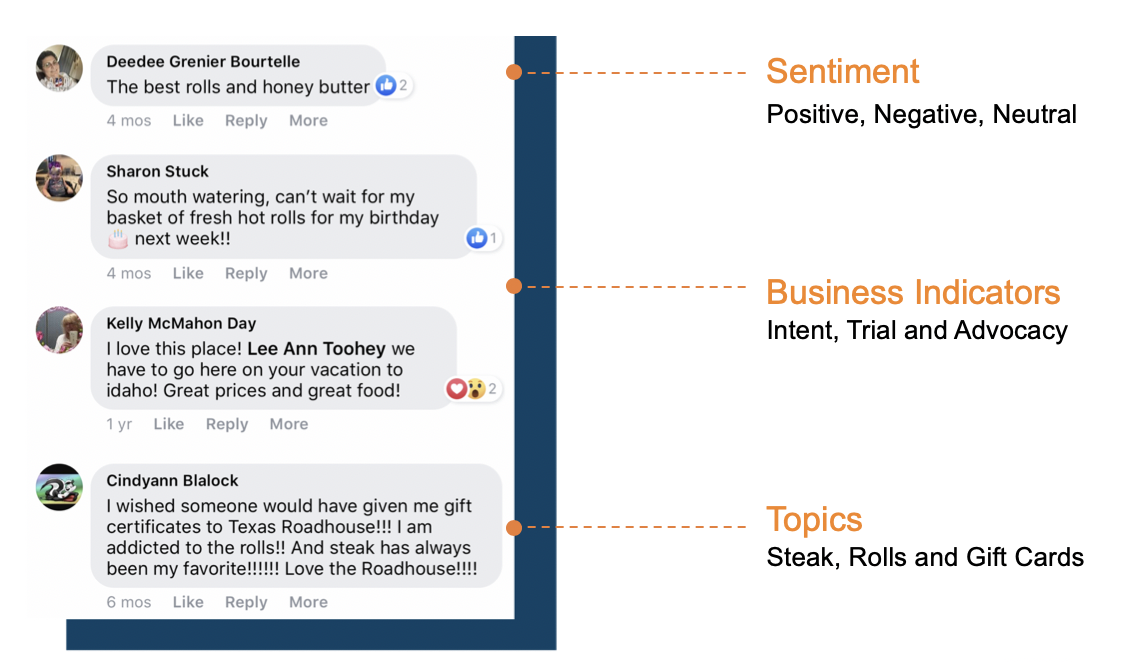
We have a problem. A head-scratching conflict between data-driven marketers and their namesake data. The battleground: social media. According to the 2019 CMO Survey, social media investments are going up while confidence in social media performance is going down1. It begs the question, why invest more in something you believe is working less? The disconnect lies in the metrics – not the medium – and AI can provide the solution.
Let’s break it down.
Being liked is overrated
While social media platforms provide initial metrics of success, it is often difficult to link social media behaviors to business building behaviors. In fact, a series of studies published in Harvard Business Review2 have shown these so-called “vanity metrics” – likes, comments, shares, et al. – do not predict sales results at all.
You have more data than you think
Off-the-shelf metrics limit your perspective. For example, the conversations on your page are rich with context to connect online and offline behaviors. This insight is lost on performance dashboards that report comment totals indiscriminately. From our experience, these comments can signal a range of sentiment and behaviors, including brand advocacy, trial and intent.

Artificial intelligence unlocks this data
Comments represent a form of data known as unstructured data. Unstructured data is much harder to analyze at scale than structured data. Several newfound AI techniques (details best reserved for another day) help us convert unstructured data into structured data. Back in the real world, this means we can process the content of thousands of comments in seconds, not hours.
Algorithmic attribution makes the data actionable
Big-data books and blogs have trained us to ask, “How can we get far more value from far more data?” But, in the age of AI, we should reframe the question, “What value matters most, and what marriage of data and algorithms get us there?”3 Enter algorithmic attribution modeling, a machine-learning approach that links performance that matters with levers we can actually pull. In social media terms, that means we can uncover previously hidden insights like how – and to what degree – specific creative decisions drive brand advocacy, trial and intent.

AI is accessible today and tomorrow
Let’s get something out of the way. AI is a buzzword. But we shouldn’t discount it. Because despite our head-nodding colleagues’ disproportionate use-to-understanding ratio, AI is projected to underpin 80% of emerging technologies by 20214, and the economics are right for businesses of all sizes to leverage it today5. The solution to social media attribution is not a byproduct of some dystopian future. It is a present reality made possible by accessible breakthroughs.
Want to learn more about how these breakthroughs can work for your business? Contact Michael Littman, CMO, or Lee Dorsey, Director of Innovation, for more information.
Sources
1The CMO Survey, February 2019 - "February 2019" The CMO Survey, February, 2019, accessed January, 2020.
2What’s the Value of a Like?, Harvard Business Review 2017 - Leslie K. John, Daniel Mochon, Oliver Emrich, and Janet Schwartz, "What’s the Value of a Like?" Harvard Business Review, March–April, 2017, accessed January, 10, 2020.
3What Executives Don’t Understand About Big Data, Harvard Business Review 2012 - Michael Schrage, "What Executives Don’t Understand About Big Data" Harvard Business Review, September 14, 2012, accessed January, 10, 2020.
4100 Data and Analytics Predictions Through 2022, Gartner 2018 - "100 Data and Analytics Predictions Through 2022" Gartner, 21 May 2018, accessed January, 10, 2020.
5Prediction Machines; The Simple Economics of Artificial Intelligence - Ajay Agrawal, Joshua Gans and Avi Goldfarb. Prediction Machines: The Simple Economics of Artificial Intelligence. Boston: Harvard Business Review Press, 2018. Print.
Credits
Photo by Prateek Katyal on Unsplash
)
)